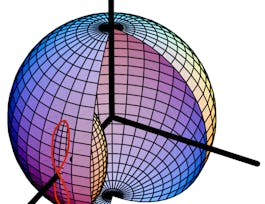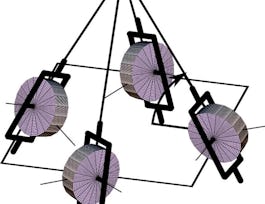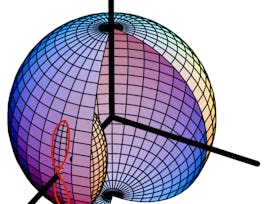As they tumble through space, objects like spacecraft move in dynamical ways. Understanding and predicting the equations that represent that motion is critical to the safety and efficacy of spacecraft mission development. Kinetics: Modeling the Motions of Spacecraft trains your skills in topics like rigid body angular momentum and kinetic energy expression shown in a coordinate frame agnostic manner, single and dual rigid body systems tumbling without the forces of external torque, how differential gravity across a rigid body is approximated to the first order to study disturbances in both the attitude and orbital motion, and how these systems change when general momentum exchange devices are introduced.


Kinetics: Studying Spacecraft Motion
This course is part of Spacecraft Dynamics and Control Specialization
Taught in English
Some content may not be translated

Instructor: Hanspeter Schaub
Top Instructor
10,286 already enrolled
Included with 
Course
(129 reviews)
What you'll learn
Derive the rotational equations of motion and predict and determine torque-free motion equilibria and associated stabilities
Develop equations of motion for a rigid body with multiple spinning components and derive and apply the gravity gradient torque
Apply the static stability conditions of a dual-spinner configuration and predict changes as momentum exchange devices are introduced
Derive equations of motion for systems in which various momentum exchange devices are present
Details to know

Add to your LinkedIn profile
25 quizzes
Course
(129 reviews)
See how employees at top companies are mastering in-demand skills

Build your subject-matter expertise
- Learn new concepts from industry experts
- Gain a foundational understanding of a subject or tool
- Develop job-relevant skills with hands-on projects
- Earn a shareable career certificate


Earn a career certificate
Add this credential to your LinkedIn profile, resume, or CV
Share it on social media and in your performance review

There are 4 modules in this course
The dynamical equations of motion are developed using classical Eulerian and Newtonian mechanics. Emphasis is placed on rigid body angular momentum and kinetic energy expression that are shown in a coordinate frame agnostic manner. The development begins with deformable shapes (continuous systems) which are then frozen into rigid objects, and the associated equations are thus simplified.
What's included
19 videos9 quizzes
The motion of a single or dual rigid body system is explored when no external torques are acting on it. Large scale tumbling motions are studied through polhode plots, while analytical rate solutions are explored for axi-symmetric and general spacecraft shapes. Finally, the dual-spinner dynamical system illustrates how the associated gyroscopics can be exploited to stabilize any principal axis spin.
What's included
17 videos9 quizzes
The differential gravity across a rigid body is approximated to the first order to study how it disturbs both the attitude and orbital motion. The gravity gradient relative equilibria conditions are derived, whose stability is analyzed through linearization.
What's included
7 videos3 quizzes
The equations of motion of a rigid body are developed with general momentum exchange devices included. The development begins with looking at variable speed control moment gyros (VSCMG), which are then specialized to classical single-gimbal control moment devices (CMGs) and reaction wheels (RW).
What's included
7 videos4 quizzes1 peer review
Instructor

Offered by
Recommended if you're interested in Physics and Astronomy

University of Colorado Boulder

University of Colorado Boulder

University of Colorado Boulder

ISAE-SUPAERO
Why people choose Coursera for their career




Learner reviews
Showing 3 of 129
129 reviews
- 5 stars
85.27%
- 4 stars
13.17%
- 3 stars
1.55%
- 2 stars
0%
- 1 star
0%

Open new doors with Coursera Plus
Unlimited access to 7,000+ world-class courses, hands-on projects, and job-ready certificate programs - all included in your subscription
Advance your career with an online degree
Earn a degree from world-class universities - 100% online
Join over 3,400 global companies that choose Coursera for Business
Upskill your employees to excel in the digital economy
Frequently asked questions
Access to lectures and assignments depends on your type of enrollment. If you take a course in audit mode, you will be able to see most course materials for free. To access graded assignments and to earn a Certificate, you will need to purchase the Certificate experience, during or after your audit. If you don't see the audit option:
The course may not offer an audit option. You can try a Free Trial instead, or apply for Financial Aid.
The course may offer 'Full Course, No Certificate' instead. This option lets you see all course materials, submit required assessments, and get a final grade. This also means that you will not be able to purchase a Certificate experience.
When you enroll in the course, you get access to all of the courses in the Specialization, and you earn a certificate when you complete the work. Your electronic Certificate will be added to your Accomplishments page - from there, you can print your Certificate or add it to your LinkedIn profile. If you only want to read and view the course content, you can audit the course for free.
If you subscribed, you get a 7-day free trial during which you can cancel at no penalty. After that, we don’t give refunds, but you can cancel your subscription at any time. See our full refund policy.

